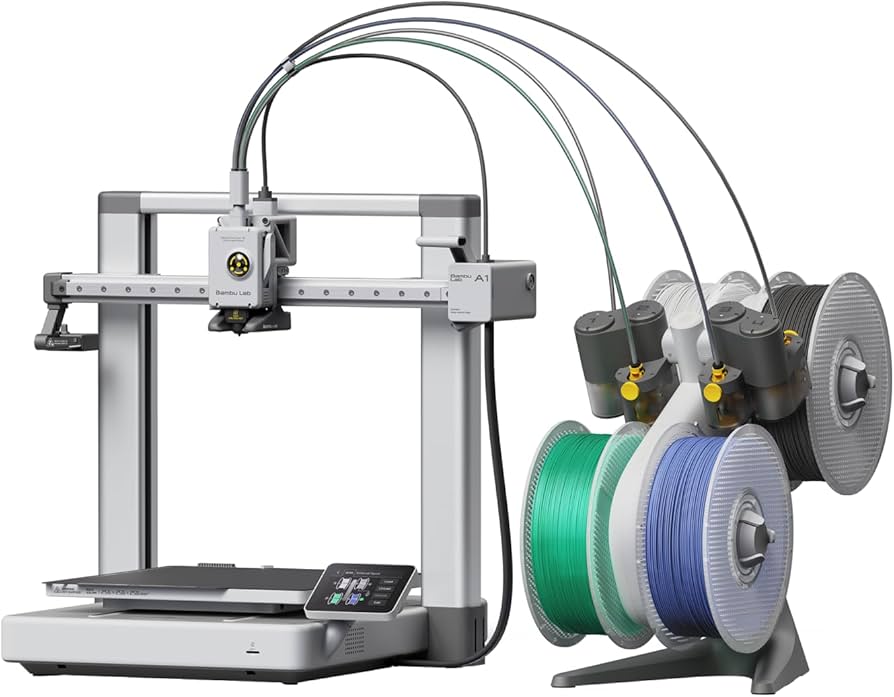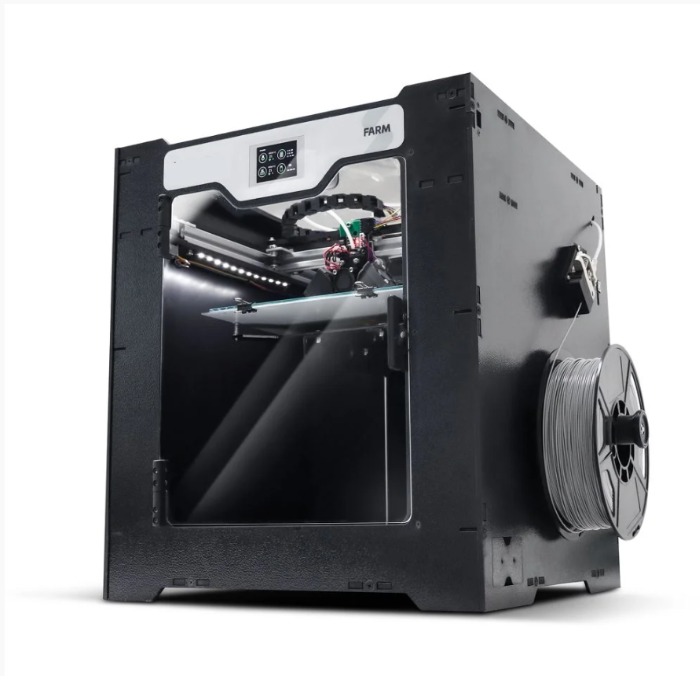Compare A1 vs FARM
Comparison between the best 3D printers
Choose the best 3D printer at the best price. The cheapest 3D printers are here.
Buy a 3D printer here with 3D Fila.
 |
 |
|
| Model | A1[BUY A1] |
FARM |
| Printing Material | Filament | Filament |
| Buy Filament for Bambu Lab A1 | Buy Filament forSethi 3D FARM | |
| Estimated price | $700,00 | $1127,00 |
| Manufacturer | Bambu Lab | Sethi 3D |
| Release Year | 2023 | 2021 |
| Print Volume [mm] | 256x256x256 | 240x240x240 |
| Printer Size [mm] | 385x410x430 | 550x42x500 |
| Weight [kg] | 8,3 | 15,7 |
| Power Loss Recovery | YES | YES |
| Enclosed printer | NO | YES |
| Bed Leveling | Automatic | Automatic |
| Filament End Sensor | YES | YES |
| Bed type | Heated | Heated |
| Power supply system | Direct Drive | Bowden |
| Standard nozzle | 0,4 | 0,4 |
| Maximum Nozzle Temperature [°C] | 300 | 270 |
| Maximum Bed Temperature [°C] | 100 | 120 |
| Maximum printing speed [mm/s] | 500 | 80 |
| Filament holder | YES | YES |
| Camera for supervision | YES | YES |
| Recommended filaments | PLA, PETG, TPU, PVA | PLA, PETG, Tritan, Flex, ABS |
| Recommended slicers | SuperSlicer, PrusaSlicer, Cura, OrcaSlicer | Cura, Simplify, Slic3r |
| Maximum Resolution [mm] | 0,1 | |
| Processor | ||
| Display | Touchscreen 3,5 | Touchscreen TFT |
| Power Supply | 350 W | 450 W |
| Connectivity | Wi-Fi, Bambu-Bus, Cartão Micro SD | USB |
| Operating systems | Windows, Linux, Macbook | Windows, Mac, Linux |
| Date of registration in the system | 2024-07-17 | 2022-10-11 |
| Release date | 2023 | 2021 |
| Extra features | The BambuLab A1 printer features fully automatic calibration, multi-color printing with the AMS system, active flow rate compensation, quick nozzle change with a clip, active motor noise cancellation, a build volume of 256x256x256 mm³, a maximum extruder temperature of 300°C, and a heated bed of up to 100°C. In addition, it has high precision, a machine health management system and an intuitive 3.5-inch touchscreen interface. | Sethis Farm printer offers a generous 240 x 240 x 240 mm print area, ideal for large projects. Its intuitive touchscreen display makes it easy to operate, while the intelligent sensor prevents problems by detecting filament shortages or jams. Its power recovery feature allows you to resume printing after interruptions. It stands out for its 9-point optical auto-leveling and high-performance heated bed, ensuring accuracy and versatility on different materials. Its 32-bit electronics and silent drivers promote a smooth and efficient experience. In addition, the Farm has a closed cabinet, expanding the range of usable polymers, and a turbo cooling system to speed up the process between prints. The machine also offers practicality with a storage drawer and simplified software updates. |
| Support for multiple colors and materials (AMS and CFS) | YES | NO |
Notes * |
||
| Cost-benefit | 7 / 10 | 6 / 10 |
| Hardware | 4.2 / 10 | 2.5 / 10 |
| Tela | . | . |
| Print volume | 4 / 10 | 3 / 10 |
| Performance | 4 / 10 | 0 / 10 |
| [BUY A1] |
Conclusion |
| In comparing the Bambu Lab A1 and the Sethi 3D Farm 3D printers, several key factors reveal important distinctions, particularly in terms of price, features, and overall value. The Bambu Lab A1 stands out for its affordability while providing impressive specifications and features. It offers a larger print volume, faster maximum printing speed, and higher extruder temperature, which enhance its versatility for a range of materials. The inclusion of advanced technologies like fully automatic calibration, multi-color printing capabilities, and an intuitive touchscreen interface further elevate its usability. Additionally, its lightweight design and compact size make it an attractive option for home users or those with limited space. On the other hand, the Sethi 3D Farm, while priced higher, offers benefits such as a fully enclosed build chamber, making it suitable for more sensitive materials. Its 9-point optical auto-leveling and robust construction promote reliable and accurate prints, which may appeal to professionals or advanced users who prioritize material diversity and print quality over initial cost. However, its slower maximum printing speed and smaller build volume limit its efficiency for larger projects. Overall, if budget is a major consideration and you're looking for a machine that excels with speed and versatility, the Bambu Lab A1 is likely the better choice. Conversely, if you require safety features, material versatility, and are willing to invest more upfront, the Sethi 3D Farm could be the right fit. Ultimately, the decision should be based on the specific needs and priorities of the user, balancing between cost and the desired features for intended projects. |

